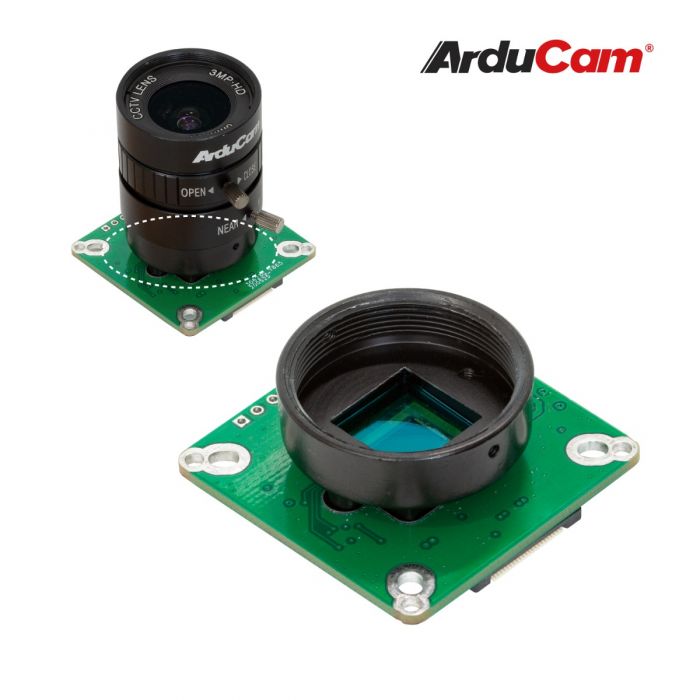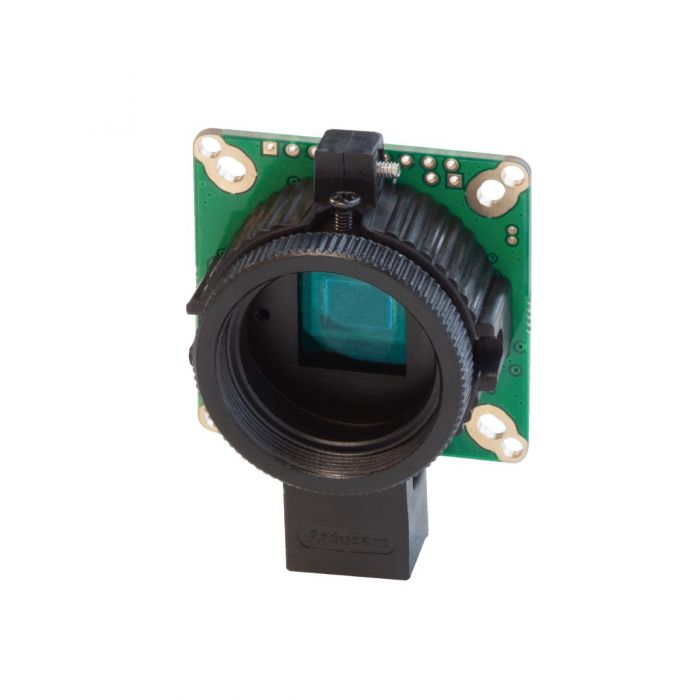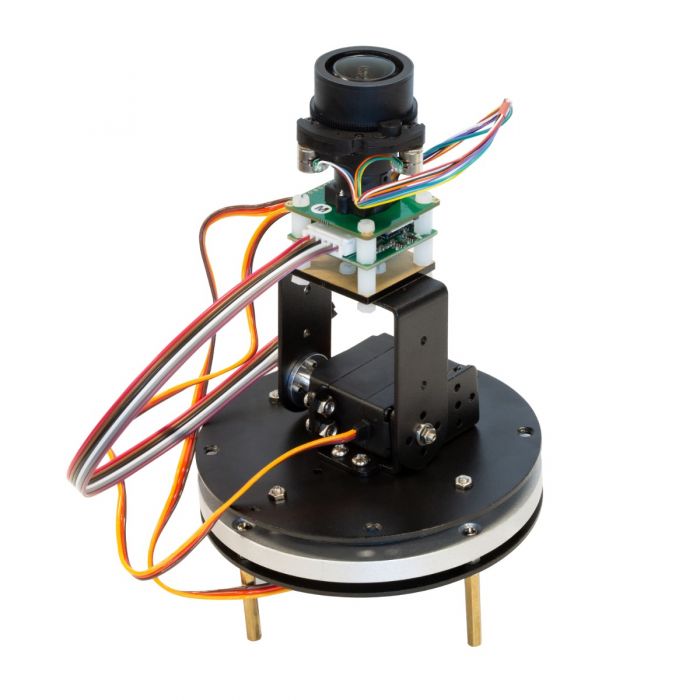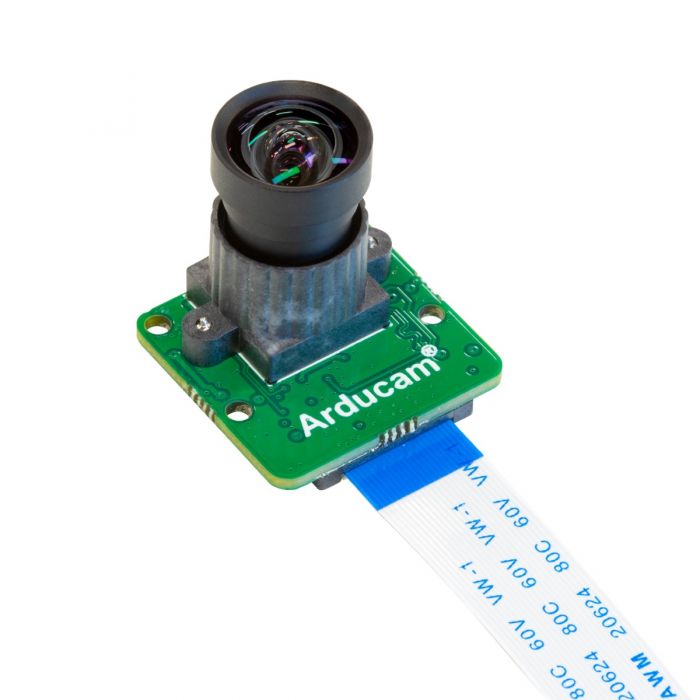1MP OV9281¶
Overview¶
The Arducam 1MP camera modules, featuring the OV9281 and OV9282 image sensors, are high-speed, global shutter cameras designed for machine vision and robotics applications on the Raspberry Pi platform. Their key advantage is the global shutter, which captures the entire frame at once, making them ideal for imaging fast-moving objects without the distortion or "jello" effects common with rolling shutter cameras.
These monochrome sensors provide excellent sensitivity and are fully compatible with all Raspberry Pi models with a MIPI CSI-2 camera connector, including Pi 5, Pi 4, Pi Zero, and Compute Modules.
Technical Specifications¶
Image Sensor Details¶
| Parameter | Specification |
|---|---|
| Sensor Model | OV9281 |
| Shutter Type | Global Shutter |
| IR Sensitivity | Monochrome |
| Active Pixels | 1280×800 |
| Resolution | 1 MP |
| Image Sensor Format | 1/4″ |
| Pixel Size | 3μm×3μm |
Key Features¶
The primary feature of the OV9281 and OV9282 sensors is their global shutter mechanism. This makes them exceptionally well-suited for applications such as:
- Drone and Autonomous Robotics: Capturing clear frames for navigation and obstacle avoidance without motion blur.
- High-Speed Monitoring: Industrial quality control, motion analysis, and security.
- Stereo Vision: The synchronized exposure is critical for building accurate depth maps.
Platform Compatibility¶
Supported Operating Systems¶
| Platform | Trixie | Bookworm (rpicam) | Bullseye (libcamera/rpicam) | Buster (raspistill) |
|---|---|---|---|---|
| Raspberry Pi 5 / CM5 | ✅ | ✅ | ❌ | ❌ |
| Raspberry Pi 4B / 3B+ / 3A+ / Zero / Zero 2 W | ✅ | ✅ | ✅ | ✅ |
| Raspberry Pi CM3 / CM3+ / CM4 Requires adapter board |
✅ | ✅ | ✅ | ✅ |
Operating System Support
This documentation focuses on Trixie, Bookworm , and Bullseye (kernel 6.1.21+) to align with the official Raspberry Pi OS release cycle. While Buster instructions are not included, we recommend migrating to a supported OS for optimal performance. For Buster-specific assistance, please contact our support team.
Product Catalog¶
| Product Image | SKU | Pin/Connect Type | Features | Lens Type | Field of View(D/H/V) | Focus Type | IR Sensitivity |
|---|---|---|---|---|---|---|---|
 |
B0452 | 22/TOP | M12 Mount | Mini Size | 75°(H) x 59° (V) | Manual Focus | 650nm IR-cut filter |
 |
B0240 | 22/TOP | CS Mount | CS | 65°(H) x 51° (V) | Manual Focus | 650nm IR-cut filter |
| B0241 | HDMI Extension Kit | 65°(H) x 48.75° (V) | Motorized IR-CUT Filter | ||||
 |
B024001 | CS Mount/Tripod | Default CS | / | / | / | |
 |
B0167B12 | 22/NA | Pan-Tilt-Zoom Kit |
Zoom Lens | H(96°-33°) x V(72°-24°) | Motorized Focus | Motorized IR-CUT Filter |
| B016712MP | |||||||
 |
B0262 | 22/TOP | Mini Size | M12 | 75°(H) x 56.3°(V) | Manual Focus | 650nm IR-cut filter |
| B0271 | 22/NA | For Compute Module |
Hardware Setup¶
For detailed hardware connection instructions, please refer to our comprehensive guide:
Quick Start Guide - Hardware Connection
Software Configuration¶
The software setup process consists of three essential components:
- System Configuration - Required initial setup for camera recognition (reboot required)
- Camera Usage - Commands for preview and image capture
- Troubleshooting - Solutions for common display issues
System Configuration¶
Important
You must reboot your Raspberry Pi after making configuration changes for them to take effect.
Raspberry Pi 5 & CM5¶
Pi 5 supports both Trixie and Bookworm OS. The configuration file is located at /boot/firmware/config.txt for both systems.
-
Open the configuration file:
sudo nano /boot/firmware/config.txt -
Disable camera auto-detection:
camera_auto_detect=0 -
Add OV9281 overlay under the
[all]section:dtoverlay=ov9281,arducam -
Save and reboot:
sudo reboot
Camera Port Configuration
For Pi 5 with cameras connected to CAM0 port, use:
dtoverlay=ov9281,cam0,arducam
Raspberry Pi 4¶
Pi 4 supports Trixie, Bookworm and Bullseye OS with different configuration file locations.
sudo nano /boot/firmware/config.txt
sudo nano /boot/config.txt
Configuration steps (same for all OS versions):
- Set
camera_auto_detect=0 - Add
dtoverlay=ov9281,arducamunder the[all]section - Save the file and reboot:
sudo reboot
Raspberry Pi Zero to Pi 3¶
These models support all operating systems with different setup procedures.
Standard configuration using /boot/firmware/config.txt:
sudo nano /boot/firmware/config.txt
- Set
camera_auto_detect=0 - Add
dtoverlay=ov9281,arducamunder[all]section - Save the file and reboot:
sudo reboot
Two-step process required:
Step 1: Edit config.txt
sudo nano /boot/config.txt
- Set
camera_auto_detect=0 - Add
dtoverlay=ov9281,arducamunder[all]section - Save the file but do not reboot yet - proceed to Step 2
Step 2: Enable Glamor Graphics
sudo raspi-config
Navigate to 6 Advanced Options → A3 Glamor → Enable → Reboot
Raspberry Pi Compute Module 3 & 4¶
CM3 and CM4 support all operating systems with dual camera ports (cam0, cam1).
sudo nano /boot/firmware/config.txt
sudo nano /boot/config.txt
Configuration steps (same for all OS versions):
- Set
camera_auto_detect=0 - Add
dtoverlay=ov9281,arducamunder[all]section - Save the file and reboot:
sudo reboot
Camera Port Selection
For CAM0 interface usage, modify the overlay line to:
dtoverlay=ov9281,cam0,arducam
Camera Usage¶
After system configuration and reboot, your camera is ready for operation.
Using rpicam-apps suite:
-
List available cameras:
rpicam-still --list-cameras -
Live preview (Ctrl+C to exit):
rpicam-still -t 0 -
Capture image with 5-second preview:
rpicam-still -t 5000 -o test.jpg
Using libcamera-apps suite:
-
List available cameras:
libcamera-still --list-cameras -
Live preview (Ctrl+C to exit):
libcamera-still -t 0 -
Capture image with 5-second preview:
libcamera-still -t 5000 -o test.jpg
For comprehensive usage instructions, refer to the Raspberry Pi Camera Documentation.
Troubleshooting¶
If you encounter display issues such as black screens, the camera may not be properly recognized by the system.
Common troubleshooting resources: - Common Troubleshooting Guide
For persistent issues, please contact our support team for additional assistance.